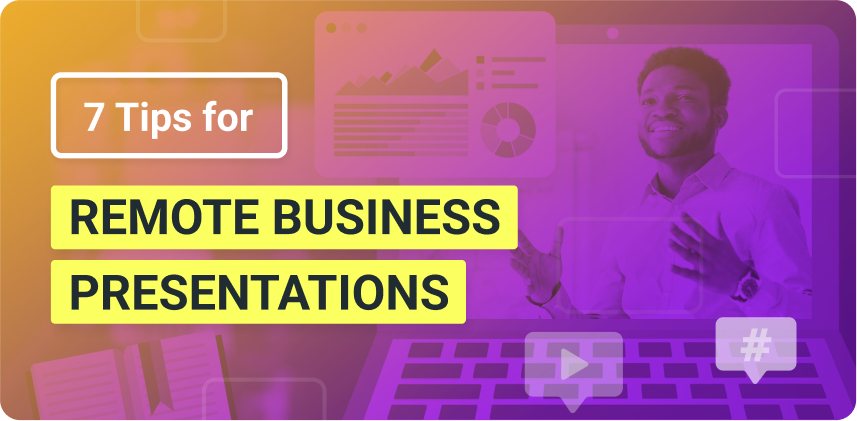Training videos can help your business maximize productivity during your onboarding process with new hires or new clients and with customer service. With a training video, you can teach viewers much more effectively, and they can learn on their own time. In this blog, you’ll learn why training videos are so important for your business and how to create them effectively. We’ll give you a step-by-step on how to plan your training video and tips on how to execute them.
Summary:
Training videos can help you teach anything you need to new employees and clients effectively to maximize your productivity.
4 Steps before shooting training videos:
- Define your goal and topic
- Know your stuff
- Choose the right format
- Plan your video (outline, script, storyboard)
5 Tips for creating training videos that matter:
- Connect with your audience
- Prepare and rehearse
- Keep the video light and short
- Vary the material
- Focus on the quality
Create your training videos with ManyCam, to get every tool in one place. Use screencasting, add slide decks, images, and videos, apply the picture-in-picture to keep your viewers engaged and more.
Training videos can maximize productivity
Videos are an excellent medium for teaching because they hit two significant senses when it comes to learning – sight and hearing. The visual and the audio of a video help viewers learn faster, without the need for an instructor present.
Hiring & Onboarding Process
For businesses, this means saving money and helping others learn faster. For instance, training videos can help companies speed up the onboarding process. Whenever they hire a new employee, the training videos can help the newcomer learn the procedures of the business. In the video, employees can learn more about the product, regardless if it’s online or physical and also learn how to use whatever applications the business uses.
Employers can, later on, gather the most frequently asked question and create videos to address them. Though creating videos can be time-consuming, it doesn’t compare to the amount of time, money and efforts saved afterward.
Customer Service
Another strategy regarding training videos that businesses can apply is creating videos for their customers. It can help the support team be more productive while assisting customers in a way they can understand. We do this on our YouTube Channel and Help page.
The best part for those learning from the videos is that they can pause and go back at any time if they miss something. It helps people learn more effectively. But, it’s also vital to allow viewers to ask questions throughout the video. Viewers will usually have some, and the business needs to be available to answer.
One suggestion here is to have scheduled meetings, in person or online, where people get to ask their questions live. Live videos are particularly useful because people get a real-time response and the video can always be available to them after. Or, if the training videos are posted on a platform that allows comments, viewers can leave their questions there for the business to reply.
How to create useful Training Videos
Before shooting your video
These three following steps are crucial for your video’s success because they will help you plan your video properly and avoid mistakes, so you don’t waste your resources.
-
Define your goal and topic
What is the primary purpose of the video? In other words, what is the most important lesson you want the employee or client to learn from watching this video? Once you have your goal, you can define your topic. The more specific your topic is, the easier it will be to plan your video.
In case your topic is too broad, and you can’t narrow it down, dividing it into a series of videos can be a great way to teach your audience. When planning a series, you should still determine the topic of each video and make sure there’s a flow between all the videos.
Nonetheless, every time you plan to produce a video, consider your target audience and research what the topics they are most interested in are.
-
Know your stuff
Once you decide the topic of the training video, make sure you know all about that topic. Or, find someone that can help you with that. To create successful training videos, you need to be 100% confident in the subject you’ll be discussing.
If you are going to have multiple topics, you can always find other people within the company to be your cohost and help you deliver the training.
-
Choose a video format
A training video can be created in many different formats. Each format has its advantages and disadvantages, choosing the right one will depend on your goal and topic. Here are some of the types:
Screencast: One of the most common and useful training videos out there are the Screencast videos. Screencasting is recording your screen. If your goal is to teach others how to do something on the computer, screencasting can help you a lot.
Microvideo: These are short 10-15 second videos that rely heavily on the visual usually demonstrating a straightforward process.
Presenter: Having a spokesperson talking to your audience and teaching them about the topic.
Demo: As the name suggests, it demonstrates how something works or is done. It’s particularly useful for physical products and process.
Roleplay: To help viewers understand a concept or a procedure better, you can create a scenario and act out situations.
-
Plan your video (outline, script, storyboard)
When you have a goal, a topic, and a format, it will be much easier to plan your video. You can create a basic outline of the video first. Then, you can decide whether the outline is enough for you or if you prefer to have a script. Make sure the script sounds like you are talking and not just reading.
Some people prefer to create Storyboards, which are a visual representation of how the video is going to go. They are especially useful for you to see if the order of the information makes sense and if the topic is easy enough to be understood.
Create training videos that matter
After planning, you can move on to the production of the training video. The following tips will help you deliver successful training videos.
Quick tip: If you are planning a series, you can try shooting more than one video at once, to save time.
TIP 1 – Connect with your audience
Whether you plan to do a screencast or any other format, it’s essential to establish a connection with your audience. When you start the video, show yourself on camera, talk to your audience and then, move on to the screen.
You can also use a Picture-in-Picture feature to make sure the audience can see you throughout the video.
TIP 2 – Preparation
Prepare all the equipment and material you might need and make sure it’s all ready to go. You can also rehearse a couple of times, and see if you got it right. If you are using any software, remember to adjust all the settings and do some tests. There’s nothing worse than recording an entire video and then realizing your microphone was off.
TIP 3 – Keep it light and short
Different than live videos and in-person training, training videos have no real-time interaction, which means, you can lose the audience’s attention quickly.
- Add a bit of fun to your video and try to make it lighter, this can help you keep your audience focused.
- Ask questions, even though you can’t hear the answers.
- Try keeping your videos under 10 minutes.
TIP 4 – Variation
To keep your audience engaged, deliver enough variety. A training video can be dynamic if you add different elements to it. For example, consider using different camera angles, screencasting, slides presentation and images. With software like ManyCam, you can transition between them seamlessly.
But don’t overdo it. Too many changes will get your viewers lost. It’s all about balance.
TIP 5 – Quality
The quality of your video matters. When running tests (tip 2), check the quality of your image and your audio. They need to be crispy and clear; otherwise, you might lose your viewers.
Where to create your training videos?
Depending on the format of the training video you decide to create, there are always different solutions out there. ManyCam is known for its applicable features in live video, but it can also be an excellent resource for recording videos.
With ManyCam, you can record videos while screencasting, showing slide decks, images and videos, and any other feature, like the Picture-in-Picture. Once you finish the video, it will be saved on your computer, and you can use it anywhere.
If you haven’t tried ManyCam yet, download it for free.
Training videos are an excellent tool to maximize your company’s productivity while ensuring that every new employee gets the same training and information. It can also improve your customer service by providing clients with practical training.
Share this post with someone that needs to start creating training videos and could use the help. If there are any other topics you’d like to see on this blog, let us know in the comment section below.
Here are other blog posts to help you grow your audience:
The Ultimate Guide to Smart Video Collaborations
Video collabs can fast-track your online growth when you find the right partners. When you create smart video collaborations on YouTube or any other platform, you get access to an entirely new potential audience in an organic and positive way... (Continue reading)
How to Live Stream with Multiple Video Sources
To create a dynamic live streaming video that people want to watch, you need to take advantage of every resource you can. In this blog post, we will show how you can live stream with multiple video sources… (Continue reading)






